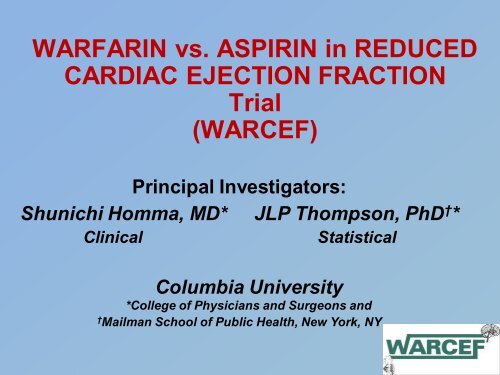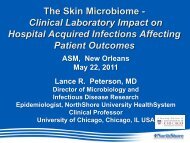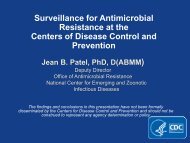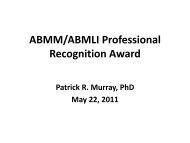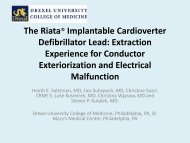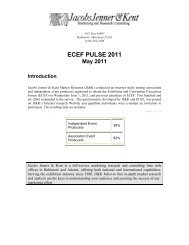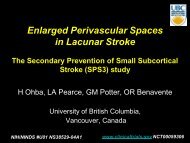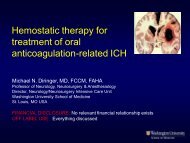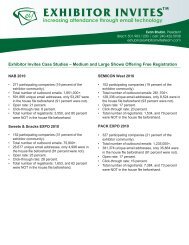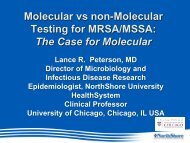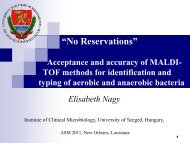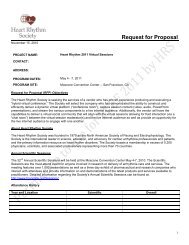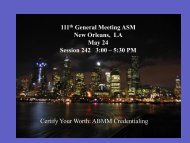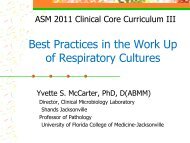Warfarin vs. Asprin in Reduced Ejection Fraction
Warfarin vs. Asprin in Reduced Ejection Fraction
Warfarin vs. Asprin in Reduced Ejection Fraction
You also want an ePaper? Increase the reach of your titles
YUMPU automatically turns print PDFs into web optimized ePapers that Google loves.
WARFARIN <strong>vs</strong>. ASPIRIN <strong>in</strong> REDUCED<br />
CARDIAC EJECTION FRACTION<br />
Trial<br />
(WARCEF)<br />
Pr<strong>in</strong>cipal Investigators:<br />
Shunichi Homma, MD* JLP Thompson, PhD † *<br />
Cl<strong>in</strong>ical Statistical<br />
Columbia University<br />
*College of Physicians and Surgeons and<br />
† Mailman School of Public Health, New York, NY
F<strong>in</strong>ancial Support Disclosures<br />
• National Institute of Neurological Disorders and Stroke<br />
U01-NS-043975 (S. Homma)<br />
U01-NS-039143 (J.L.P. Thompson)<br />
• No other disclosures<br />
• <strong>Warfar<strong>in</strong></strong>, warfar<strong>in</strong> placebo provided by Taro<br />
Pharmaceuticals U.S.A.<br />
• Aspir<strong>in</strong>, aspir<strong>in</strong> placebo provided by Bayer HealthCare
Background<br />
• Heart failure patients are at an <strong>in</strong>creased risk<br />
of death and stroke due to thromboembolic<br />
events<br />
• <strong>Warfar<strong>in</strong></strong> and aspir<strong>in</strong> are often given to heart<br />
failure patients <strong>in</strong> s<strong>in</strong>us rhythm but they have<br />
not been compared to each other <strong>in</strong> a large<br />
group of heart failure patients
Primary Aim<br />
To determ<strong>in</strong>e if warfar<strong>in</strong> or aspir<strong>in</strong> is superior for<br />
prevent<strong>in</strong>g comb<strong>in</strong>ed outcome of death, ischemic<br />
stroke, or <strong>in</strong>tracerebral hemorrhage <strong>in</strong> patients with<br />
LVEF ≤ 35% <strong>in</strong> s<strong>in</strong>us rhythm<br />
Ma<strong>in</strong> Secondary Aim<br />
To determ<strong>in</strong>e if warfar<strong>in</strong> or aspir<strong>in</strong> is superior for<br />
prevent<strong>in</strong>g comb<strong>in</strong>ed outcome of death, ischemic<br />
stroke, <strong>in</strong>tracerebral hemorrhage, MI, or heart<br />
failure hospitalization <strong>in</strong> patients with LVEF ≤ 35%<br />
<strong>in</strong> s<strong>in</strong>us rhythm
Key Inclusion Criteria<br />
1. Normal s<strong>in</strong>us rhythm<br />
2. LVEF35%<br />
3. No def<strong>in</strong>ed cardioembolic source<br />
4. On optimum heart failure regimen
• Double-Bl<strong>in</strong>d Multicenter Study<br />
<strong>Warfar<strong>in</strong></strong> (INR 2 – 3.5) <strong>vs</strong>. ASA (325mg)<br />
• Echo Core Lab to confirm site determ<strong>in</strong>ed<br />
LVEF<br />
• Timel<strong>in</strong>e<br />
Study Design<br />
Recruitment: October 2002 to January 2010<br />
Follow-up ended: July 2011
Statistical Design<br />
• Primary null hypothesis<br />
No overall difference between warfar<strong>in</strong> (target<br />
INR 2.75) and aspir<strong>in</strong> (325 mg/day) <strong>in</strong> time to first<br />
to occur of ischemic stroke, <strong>in</strong>tracerebral<br />
hemorrhage, or death.<br />
• = 0.05 two-sided for superiority<br />
• Power 80% for 17.8% HR reduction.<br />
(achieved 67% after recruitment curtailed)<br />
• Given long follow-up (6 yrs maximum),<br />
prespecified analysis provides for a time-vary<strong>in</strong>g<br />
treatment effect (treatment by time <strong>in</strong>teraction) if<br />
hazards are nonproportional
Enrollment: 11 countries, 176 sites, 2,305 patients<br />
Canada: 216<br />
United States: 903<br />
United K<strong>in</strong>gdom: 41<br />
Germany: 134<br />
Czech Republic: 173<br />
Slovakia: 27<br />
Hungary: 152<br />
Argent<strong>in</strong>a: 92<br />
Netherlands: 189<br />
Poland: 263<br />
Ukra<strong>in</strong>e: 115
Randomized, n<br />
Lost to Follow-up, n<br />
Withdrew Consent, n<br />
Mean Follow-up (range)<br />
Total Patient Years<br />
Enrolled Patients<br />
<strong>Warfar<strong>in</strong></strong> Aspir<strong>in</strong><br />
1142<br />
17<br />
14<br />
3.54 (1-6) yrs<br />
4045<br />
1163<br />
18<br />
20<br />
3.47 (1-6) yrs<br />
4033
Basel<strong>in</strong>e F<strong>in</strong>d<strong>in</strong>gs<br />
<strong>Warfar<strong>in</strong></strong><br />
(N=1142)<br />
Aspir<strong>in</strong><br />
(N=1163)<br />
Age 61 ± 11.6 yrs 61 ± 11.1 yrs<br />
Male sex (%) 904 (79.3 %) 936 (80.7 %)<br />
Prior stroke/ TIA (% ) 155 (13.6 %) 139 (12.0 %)<br />
NYHA Classification (%)<br />
I 150 (13.2 %) 165 (14.3 %)<br />
II 621 (54.6 %) 646 (56 %)<br />
III 351 (30.9 %) 329 (28.5 %)<br />
IV 15 (1.3 %) 13 (1.1 %)<br />
<strong>Ejection</strong> <strong>Fraction</strong> 25 ± 7.5 % 25 ± 7.5 %
Basel<strong>in</strong>e Medication<br />
Time <strong>in</strong> Therapeutic Range<br />
<strong>Warfar<strong>in</strong></strong><br />
(N=1142)<br />
Aspir<strong>in</strong><br />
(N=1163)<br />
Aspir<strong>in</strong> /Other Antiplatelet 65.9 % 67.7 %<br />
<strong>Warfar<strong>in</strong></strong>/other OAC 7.9 % 7.7 %<br />
ACE Inhibitor/ARB 98.4 % 98.4 %<br />
Beta Blocker 90.3 % 89.5 %<br />
Aldosterone Blocker 61.0 % 59.9 %<br />
Nitrate 25 % 22.4 %<br />
Diuretic 81.4 % 80.3 %<br />
Stat<strong>in</strong> 83.4 % 82.7 %<br />
Defibrillator 18.6 % 17.8 %<br />
Mean INR 2.5 ± 0.95<br />
Time <strong>in</strong> Therapeutic Range (2-3.5) 63%
No. at Risk<br />
Primary Outcome<br />
Aspir<strong>in</strong> 4,033 patient years (320 endpo<strong>in</strong>ts; 7.93% per year)<br />
<strong>Warfar<strong>in</strong></strong> 4,045 patient years (302 endpo<strong>in</strong>ts; 7.47% per year)<br />
Overall HR = 0.93 (0.79-1.10) p=0.40<br />
Proportional Hazards<br />
assumption violated<br />
Primary Analysis: Tx by Time Interaction<br />
Aspir<strong>in</strong> 1163 1073 860 658 508 329 94<br />
<strong>Warfar<strong>in</strong></strong> 1142 1049 852 653 525 363 115<br />
aspir<strong>in</strong><br />
warfar<strong>in</strong>
<strong>Warfar<strong>in</strong></strong> <strong>vs</strong>. Aspir<strong>in</strong> Hazard Ratios by Year of Follow-up*<br />
(Prespecified Time-Vary<strong>in</strong>g Analysis)<br />
Hazard Ratio for <strong>Warfar<strong>in</strong></strong> versus Aspir<strong>in</strong><br />
2.0<br />
1.8<br />
1.6<br />
1.4<br />
1.2<br />
1.0<br />
0.8<br />
0.6<br />
0.4<br />
0.2<br />
0.0<br />
Aspir<strong>in</strong><br />
better<br />
<strong>Warfar<strong>in</strong></strong><br />
better<br />
Significant Treatment by Time Interaction:<br />
HR multiplier per year: 0.894 (0.800, 0.998), p=0.046.<br />
0 1 2 3 4 5 6<br />
Year<br />
Aspir<strong>in</strong> 1073 860 658 508 329 94<br />
<strong>Warfar<strong>in</strong></strong> 1049 852 653 525 363 115<br />
*Estimated from time-vary<strong>in</strong>g model <strong>in</strong> cont<strong>in</strong>uous time
Death<br />
Components of Primary Outcome<br />
<strong>Warfar<strong>in</strong></strong> (N=1142)<br />
4,045 yrs<br />
Aspir<strong>in</strong> (N=1163)<br />
4,033 yrs<br />
n Rate/yr n Rate/yr<br />
268 6.63% 263 6.52%<br />
Ischemic<br />
stroke 29 0.72% 55 1.36%<br />
Intracerebral<br />
hemorrhage 5 0.12% 2 0.05%<br />
Hazard Ratio†<br />
(95% CI)<br />
1.01 (0.85-1.21)<br />
0.52 (0.33 - 0.82)<br />
2.22 (0.43 - 11.66)<br />
P-<br />
Value<br />
0.91<br />
0.005<br />
0.35
No. at risk<br />
Ma<strong>in</strong> Secondary Outcome<br />
<strong>Warfar<strong>in</strong></strong> 3,519 patient years 447 endpo<strong>in</strong>ts<br />
Aspir<strong>in</strong> 3,582 patient years 435 endpo<strong>in</strong>ts<br />
<strong>Warfar<strong>in</strong></strong><br />
(12.70% per year)<br />
Aspir<strong>in</strong><br />
(12.15% per year)<br />
Overall HR 1.07 = (093,1.23) p=0.33<br />
Aspir<strong>in</strong> 1163 1004 750 554 419 270 75<br />
<strong>Warfar<strong>in</strong></strong> 1142 954 735 541 426 291 88
Major Hemorrhage<br />
(Frequencies* : Rate /yr)<br />
<strong>Warfar<strong>in</strong></strong> Aspir<strong>in</strong> Rate P<br />
Ratio<br />
Overall 72 (1.78%) 35 (0.87%) 2.05
Conclusions<br />
• No overall difference for Primary Outcome<br />
• Suggestive benefit of warfar<strong>in</strong> for Primary<br />
Outcome at 4 years and beyond<br />
• <strong>Warfar<strong>in</strong></strong> reduces ischemic stroke risk<br />
throughout follow-up<br />
• More major hemorrhage with warfar<strong>in</strong>, but<br />
<strong>in</strong>tracerebral and <strong>in</strong>tracranial hemorrhage similar<br />
• No difference for the Ma<strong>in</strong> Secondary Outcome<br />
(Primary Outcome + MI and HFH)
CLINICAL IMPLICATIONS<br />
• Given no overall benefit of warfar<strong>in</strong> and<br />
<strong>in</strong>creased risk of bleed<strong>in</strong>g, <strong>in</strong> spite of<br />
suggestive benefit at 4 years and beyond,<br />
there is no compell<strong>in</strong>g evidence to use<br />
warfar<strong>in</strong> or aspir<strong>in</strong> for all patients.<br />
• Given effectiveness <strong>in</strong> prevent<strong>in</strong>g stroke,<br />
and possible benefit of warfar<strong>in</strong> after 4<br />
years, analyses be<strong>in</strong>g performed to identify<br />
groups that will benefit from warfar<strong>in</strong> or<br />
aspir<strong>in</strong>.
STUDY ORGANIZATION<br />
Sponsor – the National Institute of Neurological<br />
Disorders and Stroke.U01-NS-043975 (S.<br />
Homma), and U01-NS-039143 (J.L.P.<br />
Thompson)<br />
Executive Committee – S. Homma, J.L.P<br />
Thompson, P. Pullic<strong>in</strong>o, R. Freudenberger, S.<br />
Graham, J. Teerl<strong>in</strong>k, S. Ammon, D. Mann, J.P.<br />
Mohr, R.L. Sacco, B. Massie, S. Anker, A.<br />
Labovitz, and C. Moy (NIH project scientist)<br />
Cl<strong>in</strong>ical Coord<strong>in</strong>at<strong>in</strong>g Center – S. Homma,V.<br />
Mejia, A. Gabriel, S. Borden, E. Peña, C. Harris,<br />
R. Khadouri, D. Gohs, M. Brown, G. Berry, D.<br />
Disantis, M. Scull<strong>in</strong>, P. Smith, S. Kohsaka, W.<br />
Watson, and L. Guillory.<br />
Statistical Analysis Center – J. L. P. Thompson,<br />
B. Lev<strong>in</strong>, R. Buchsbaum, M. Del Valle, A.<br />
Sanford, G. Levy, K. Tea, J. Grier, L. Swydan, B.<br />
O’Hare, R. Prodhan, R. Arb<strong>in</strong>g, E. Flanagan, E.<br />
Duverger, A. Peljto, W. Lo, A. Tierney, A.<br />
Henriquez, and J. Keen.<br />
CEC – J.R. Teerl<strong>in</strong>k, S. Ammon, S. Slomiak, and<br />
L. Cape. Neurology Adjudicators – H.J.M.<br />
Barnett, A. Bruno, J.D. Easton, S. Lev<strong>in</strong>e, and<br />
D. Sahlas; Cardiology Adjudicators – F. Bleyer,<br />
P. Carson, A. Ellis, A. Miller, and S.T. Palmeri;<br />
Hemorrhage adjudicator – R. Hart.<br />
Core Echo Lab: A. Labovitz, M. Di Tullio,<br />
M.Bierig, R. Liu, and C. Donato.<br />
DSMB – G.J. del Zoppo, G.W. Albers, M.<br />
Eliasziw, J.A. H<strong>in</strong>chey, K.C. Johnston, A.M.<br />
Lowe, I.L. Piña, J.A. Swa<strong>in</strong>, and P. Gilbert (NIH<br />
liaison)
Thank you to:<br />
• Site <strong>in</strong>vestigators and<br />
coord<strong>in</strong>ators<br />
• CCC and SAC team members<br />
• CEC Committee members<br />
• DSMB members<br />
• NINDS<br />
• All study volunteers


